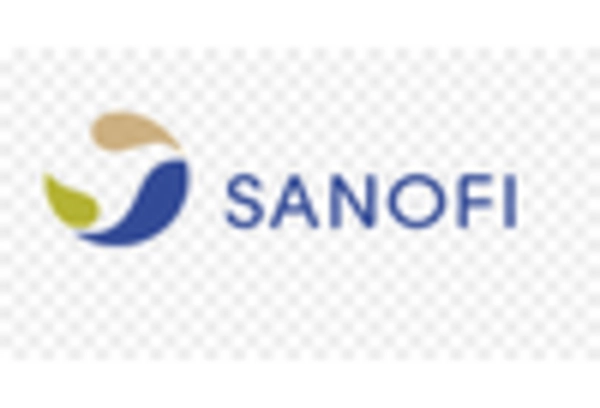Rising Healthcare Expenditure
Rising healthcare expenditure in the GCC region is a significant driver for the onychomycosis market. Governments and private sectors are increasingly investing in healthcare infrastructure, leading to improved access to medical services and treatments. This trend is reflected in the growing budget allocations for dermatological care, which includes the treatment of fungal infections like onychomycosis. As healthcare spending rises, patients are more likely to seek treatment for onychomycosis, thereby boosting the market. Reports suggest that healthcare expenditure in the GCC is projected to grow by approximately 5-7% annually, which could translate into increased availability of antifungal medications and therapies. This financial commitment to healthcare is likely to enhance the overall management of onychomycosis, fostering a more robust market environment.
Growing Incidence of Onychomycosis
The rising incidence of onychomycosis in the GCC region is a primary driver for the onychomycosis market. Factors such as increased humidity and warm climates contribute to the proliferation of fungal infections. Recent studies indicate that the prevalence of onychomycosis in the GCC may reach up to 10-15% of the population, particularly among older adults and individuals with compromised immune systems. This growing incidence necessitates effective treatment options, thereby propelling the demand for antifungal medications and therapies. As healthcare providers become more aware of the condition, the market is likely to expand, with a focus on innovative treatment solutions tailored to the unique needs of the GCC population. The increasing burden of this condition underscores the importance of addressing onychomycosis within the healthcare framework of the region.
Increased Focus on Dermatological Health
An increased focus on dermatological health among the GCC population is driving the onychomycosis market. As awareness of skin and nail health rises, individuals are more inclined to seek medical advice for conditions like onychomycosis. This shift in consumer behavior is influenced by various factors, including the proliferation of health campaigns and the availability of information through digital platforms. The GCC region has witnessed a surge in dermatology clinics and specialized healthcare providers, which facilitates access to treatment options. Consequently, the market for onychomycosis is expected to expand as more patients seek effective solutions for their nail health issues. The emphasis on dermatological care not only addresses the aesthetic concerns associated with onychomycosis but also highlights the importance of overall health and well-being.
Technological Advancements in Diagnostics
Technological advancements in diagnostic tools are significantly influencing the onychomycosis market. The introduction of rapid diagnostic tests and advanced imaging techniques allows for quicker and more accurate identification of fungal infections. These innovations enhance the ability of healthcare professionals to diagnose onychomycosis early, which is crucial for effective treatment. In the GCC, the adoption of such technologies is expected to increase, potentially leading to a market growth rate of around 8-10% annually. Improved diagnostics not only facilitate timely intervention but also contribute to better patient outcomes, thereby driving demand for associated treatment options. As the healthcare infrastructure in the GCC continues to evolve, the integration of advanced diagnostic technologies will likely play a pivotal role in shaping the future of the onychomycosis market.
Growing Demand for Over-the-Counter Treatments
The growing demand for over-the-counter (OTC) treatments is emerging as a key driver in the onychomycosis market. With an increasing number of individuals seeking convenient and accessible treatment options, OTC antifungal products are gaining popularity in the GCC. This trend is partly attributed to the rising awareness of onychomycosis and the desire for self-management among patients. Market data suggests that the OTC segment could account for a substantial share of the overall market, potentially reaching 30-40% in the coming years. The availability of various formulations, including topical solutions and nail lacquers, caters to diverse consumer preferences. As more individuals opt for OTC treatments, the onychomycosis market is likely to experience significant growth, driven by the convenience and effectiveness of these products.

















Leave a Comment